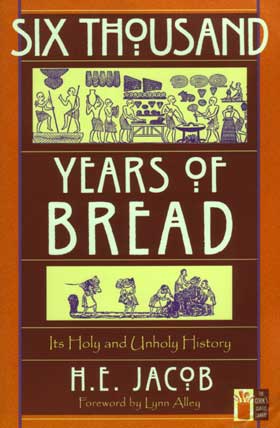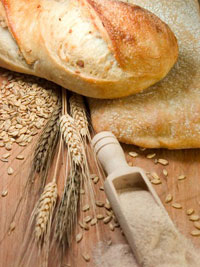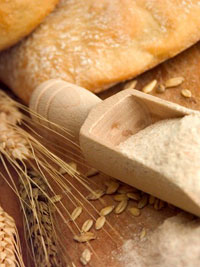Six Thousand Years of Bread
Its Holy and Unholy History
by H. E. Jacob
translated by Richard & Clara Winston
illustrations: 8 half-tone, 27 line-cut; 2 maps
Doubleday: New York, 1944
399 pages
with a foreword by Lynn Alley
Lyons Press: New York, 1997
 I had always known bread was a staple of life. Rarely has a day gone by when I have not consumed it in one form or another. But I had no idea what an important role it played in the development of historical record.
I had always known bread was a staple of life. Rarely has a day gone by when I have not consumed it in one form or another. But I had no idea what an important role it played in the development of historical record.
Bread has been the cause of revolution — and the subject of strategic war tactics. It has contributed to the development of civilized society — and torn it asunder. Bread has been used as a political pawn, a currency, a center of power, and the center of a religion. Ovens have been worshipped as holy, magical devices, and wheat has been sacrificed to invisible gods. In short, our daily bread has become a critical part of our history and development as human beings.
Over a twenty-year period, author Heinrich E. Jacob researched and composed a tome of gastronomic revelation entitled Six Thousand Years of Bread: Its Holy and Unholy History. Lost in obscurity for many decades, author Lynn Alley resurrected it and convinced a publishing house to reprint it. We are very fortunate that she did.
When the book was originally published in the 1940s, the The Wall Street Journal commended its author, stating "In writing the story of bread, a colossal epic tale, Mr. Jacob has sketched a world history — its folkways, its religion, its superstition and its plagues, all in terms of bread."
Jacob's poetic prose is sometimes tangential, but he delivers such fascinating tidbits that a reader cannot possibly mind the distraction. In explaining the development of bread in ancient Egypt, where it originated, he says: "The threshing floor is the battlefield between the tenacity of the stalk and men's hunger for flour."
He treats the farmer and the scientist as heroic, as the commendable geniuses who determined how to grow wheat during Siberian winters. "The grain that gives life to man lives in its turn only through the grace of man."
 I have always been fascinated by the role of accidental discovery in the development of cuisine. Bread would never have come into creation were it not for a few curious Egyptians who were brave enough to leave their bread to "decay", thus subjecting it to fermentation. They then figured out that hot coals were not the optimal cooking method, and devised ovens in which to bake the bread. Ingenious! Look at the contribution those curious few made to the history of man. As Jacob puts it, "Who can trace all the inventions that followed upon the great primary discovery?"
I have always been fascinated by the role of accidental discovery in the development of cuisine. Bread would never have come into creation were it not for a few curious Egyptians who were brave enough to leave their bread to "decay", thus subjecting it to fermentation. They then figured out that hot coals were not the optimal cooking method, and devised ovens in which to bake the bread. Ingenious! Look at the contribution those curious few made to the history of man. As Jacob puts it, "Who can trace all the inventions that followed upon the great primary discovery?"
 Jacob then leads us through the time of Moses and the Jewish laws of unleavened bread, through ancient Greece, where the Church of Eleusis was crafted as a temple of — that's right — bread. Along with this church was created a secret cult of worshippers, whose initiation rites remain a secret to this day, as each member kept his vow of silence.
Jacob then leads us through the time of Moses and the Jewish laws of unleavened bread, through ancient Greece, where the Church of Eleusis was crafted as a temple of — that's right — bread. Along with this church was created a secret cult of worshippers, whose initiation rites remain a secret to this day, as each member kept his vow of silence.
He then guides us down the path toward modern times, from the initial rejection of maize and potatoes as sources of flour to bread rationing in the great wars.
While Jacob was imprisoned in the Buchenwald concentration camp from 1938 to 1939, his wife carefully hid away his manuscript of Six Thousand Years of Bread so it would not be destroyed. We owe great thanks to her for such diligence, as the loss of such a magnificent work would have been a loss to mankind.
I recommend that you read this book curled up in a cozy chair with a cup of tea and a fresh, warm slice of rye. Your view of history is about to be changed.
Review & photos © 2005 The Gilded Fork
and Jennifer L. Iannolo
Jacob's title sometimes is written numerically as
6000 Years of Bread
Photos by Kelly Cline
Jennifer Iannolo's
archived gastronomic meditations
The Gilded Fork
Museum Brot und Kunst, Forum Welternährung
(Museum of Bread and Art, World Nutrition Forum)
— or —
Museum Brot und Kunst
(Museum of Bread and Art)
Ulm, Germany
displays artifacts & artwork
of the culture and history of bread
R. W. Franson's review of
Bread Overhead
by Fritz Leiber
Antiquity at Troynovant
ancient times;
Classical world & worldview:
base and noble people, events, ideas
Europe at Troynovant
Europa in general
geography, peoples, culture
| Troynovant, or Renewing Troy: | New | Contents | |||
| recurrent inspiration | Recent Updates | |||
|
www.Troynovant.com |
||||
|
Reviews |
||||
| Personae | Strata | Topography |
|
|||